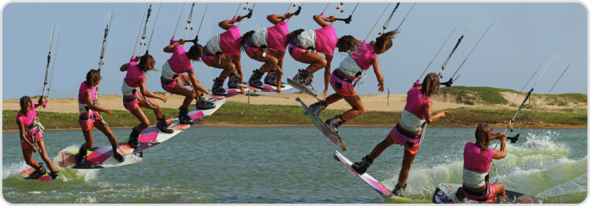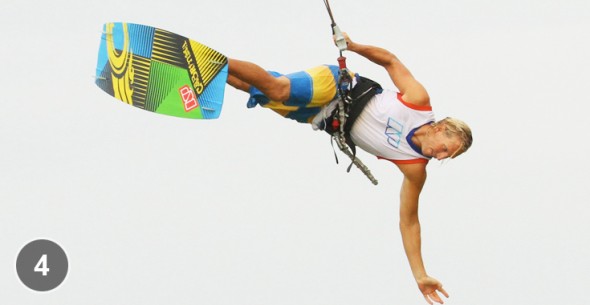Indy Pop to Blind
Before trying Indy pop to blind trick you must be reading well below instructions and practice it with right way. You can have every possible trill which is there in kite surfing. By understanding what to do and how to do can make all the difference.
And as we have often said it’s a great way to freshen up and reignite your passion fats move that you already have in the bag – so it’ll not only look the puppy’s but also feel do booth! Here we have a hooked in pop to blind with a back hand grab on the toe side rail in between your feet. You should already have the ability to pop around to blind and ride and if you don’t then hopefully this will be the incentive you need to learn.
The Set Up- Pic A
When you search for your pop you will require two things, the obvious one being speed with a dose of power and the less obvious one is a good body position, which is always much required. Whilst learning you can afford yourself the luxury of a third one, which is lift from the kite. No need to have it down at 45° when a forgiving 1 or 11 o’clock will help you on your way. Here we can see in the image that the body position as the rider carves back up into her pop. Her front leg is extended, meaning that her hips, and weight are pushed back towards the tail of the board and her shoulders are also leaning back. Surfer adopted this position before she turned off the wind and has held it throughout her carves. This very sturdy position enables her to pop explosively off her back leg. Before we continue take note that your hands should be centered on the bar and your kite parked still.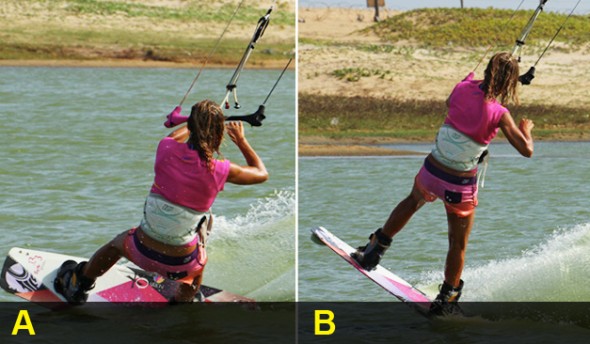
The Explosion Pic B
From such a solid set up the pop should be easy and simple. As long as you turned off the wind before carving up both the kite and the board will behave, that is to say the kite will give you something to pop against and your board won’t slow down too much as you carve. To get maximum pop you must keep your shoulders back and upwind of the board, your bum low and close to the water and you must not soften your back knee as you carve up. The rider has stamped down hard against the board with her back foot, explosively kicking herself away from her edge, and with her weight back and she takes off nose first. In anticipation of not having much time to grab she is already releasing her back hand from the bar as she stamps.
Board Up Pic C
As with any pop you need to wait until you’ve extended your body to get full elevation up, but as soon as you have it’s chop-chop to get the grab in. In picture, having already released hand, her next job is to bring her knees up towards her so that the board is within grabbing distance. The rider looks down towards where she’ll grab as she lifts the board and keeps her knees apart so that there is room for her arm to reach down towards the edge of the board. Also as a result of popping hard the back of her board kicks around and out slightly which has the effect of turning the rider back and away from the kite. This is good as it pushes which in turn gives her more room to reach down with her back hand.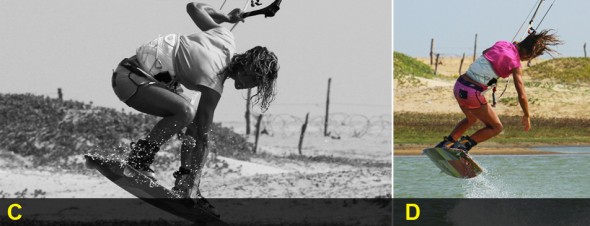
The Grab Pic D
With the board flicking around, roots for the back hand to reach down and the knees pulling everything up she can happily grab the board for a solid Indy. In this picture you can see the result of all that has gone before – the bar is in front of her and she has plenty of roots to reach and hold the grab without the need to be a contortionist. Whilst you have the grab sirs to keep the bar in on the sweet spot so that you’ll have a modicum of support from the kite, you’ll keep your forward momentum for the landing, and you’ll be able to dump the pull when you need to turn to blind.
Throw the Blind Pic E
A very good thing about the grab is that it naturally makes you stall your turn or throw to blind. Blind is always a last second movement, hence why we can do a by pop to blind. The higher you go, the longer you have to wait in order to keep your balance and control the landing. Once you feel that you’ve got the grab and you know that you’re coming data it’s time to turn. The action will come from your hips and your back leg whilst your free arm will balance you. The rider has released her grab and now commits to blind. To turn the board she twists her hips and pulls her back leg up towards her bottom and around towards the water. The board will naturally want to fall tail first so she focuses on pulling her back leg up. By doing this she will rotate around her harness hook and should make it all the way.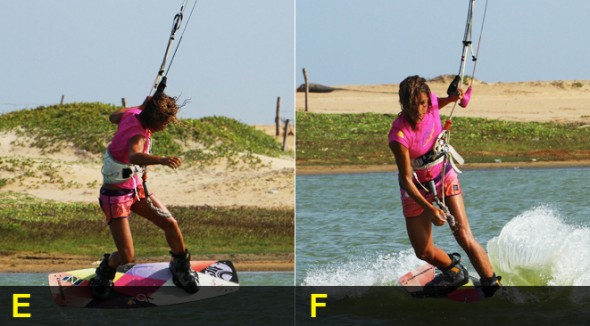
Landing Pic F
Landing this should be as per your pop to blind, though chances are as you’ve had more height you will have less momentum to keep you going once you plant the board. Make an effort to keep your back foot up so that you can plant the front of the board into the water for landing. This way as the nose catches the board will pivot off the wind more and you’re more likely to keep moving. If you land flat on your edge you’ll just stop. You can see that the rider has landed nose first with her front leg fairly straight, whilst her back leg is bent so that the board will turn further away from the wind on landing
She is already in her default blind position so that she will keep moving. If you have slowed too much pull the bar in to get some oomph from your kite.
Top Tips
- First of all you should practice the Indy if you never tried it before.
- Getting the board flicking you slightly around on take-off does make the movement of turning to blind in the air much easier as you have less far to turn and thus your body is in a better position.
- Try looking back at where you came from as you grab, this will help you turn during your Indy.
- Although we’ve said you don’t want your kite too low, don’t have it any higher than 11 or 1 o’clock. It still needs to be pulling forward to allow for some flick, an easy grab, and momentum on landing.
Common Problems
- If you can’t reach to the grab then ensure you’re popping hard enough. The pop will help you lift the board as the water will cork the board back up at you.
- Also make sure you turn to face slightly back to get the bar and your harness out of the way.
- If you’re falling backwards as you land. If your body is further downwind than the board when you land you need to sheet the bar out as you throw the blind.
- If you’re landing and then falling chances are that you’re landing flat or tail first, so concentrate on keeping that back foot up and close to your bottom so that the board can pivot.
Keystones
- Turn up and pop hard
- Release back hand and look for grab
- Lift board and look back
- Throw to blind using hips and back leg
- Keep back leg up to land nose first
One Handed Tabletop
It’s a classic one and it will never going to get out of style. Now you can learn this from TOP to bottom with the aid of below instructions. And to do this trick you need to understand that it’s a wind game and there is no surprise knowing that when the wind is high, you have to walk with it and literally kiter’s bag of tricks can be weaken. Bye this reason expanding your air game is a very mandate, hence when the wind calls, as it so often does when you’ve set your heart on unhooking or that cheeky dark slide, you can still have an array of moves to amaze your peers and more significantly keep yourself well entertained. Today’s trick “The table top” comes very much from windsurfing and was championed in kiting by many of the early adopters. All you really require is to be happy with a grabbed jump; if you can ride blind you’ll have the movement already!
If you’re not certain what a “Table top” should look like, just go through with the sequence images and get the right idea. This move requires you to take your back hand off the bar and throw it behind you whilst twisting your body and scissoring your legs. The more you invert the more likely that your board will be upside down and that is when you have a purist’s table top. However on a twin tip we reckon not inverting too much looks better, but whatever rocks your boat. So here we proceed to it.
The Foundation Pic 1
Your prospective table top won’t be much if you don’t provide it the legs on take-off. You will be hanging slightly off your front hand as  you swing yourself into this and therefore your jump needs to be more send than bow. You can see in images that rider has given the kite a good send by the angle of his bar. Over here the push and pull action is very important as you’ll have your hands very centered so that you don’t make any rash moves once you’re up, but this does mean that your hands have less impact when you send the kite back. You need a decent send to give you the height and get you flying with the kite behind 12. If you don’t send it past 12 and just pull in for lift you will redirect the kite too much once you go for the table top. How far back you go will depend on kite size and wind strength, nothing too extreme as you still want float. Needless to say Christian has a good edge coming into this and he is looking upwind not at the kite.
you swing yourself into this and therefore your jump needs to be more send than bow. You can see in images that rider has given the kite a good send by the angle of his bar. Over here the push and pull action is very important as you’ll have your hands very centered so that you don’t make any rash moves once you’re up, but this does mean that your hands have less impact when you send the kite back. You need a decent send to give you the height and get you flying with the kite behind 12. If you don’t send it past 12 and just pull in for lift you will redirect the kite too much once you go for the table top. How far back you go will depend on kite size and wind strength, nothing too extreme as you still want float. Needless to say Christian has a good edge coming into this and he is looking upwind not at the kite.
Get Settled Pic 2
Once you do take off make sure you’re balanced, settled and that the kite is where you want it, just behind 12 o’clock. There is no great rush as you won’t be able to hold the one handed position indefinitely. As the rider launches himself skywards he brings the bar in to make sure that he’s got tension on the lines for float, and this also lets him feel if the kite is supporting him and from where – you’ll feel the kite pulling from anywhere but up if it’s in the wrong place!
that the kite is where you want it, just behind 12 o’clock. There is no great rush as you won’t be able to hold the one handed position indefinitely. As the rider launches himself skywards he brings the bar in to make sure that he’s got tension on the lines for float, and this also lets him feel if the kite is supporting him and from where – you’ll feel the kite pulling from anywhere but up if it’s in the wrong place!
By pulling the bar in with two hands it guarantees that the kite won’t move much as you release and swing into the move.
The Moment of Truth Pic 3
Now that you’re comfy it’s time to go. The rider has released his back hand, swung his arm back and turned his head to look down at the water behind him. This action will swing you around so that along with your hea d, your body and legs will turn too. Looking down allows your shoulders to drop, which will lift the board a little. The movement itself is fairly simple, almost like throwing a blind in the air.
d, your body and legs will turn too. Looking down allows your shoulders to drop, which will lift the board a little. The movement itself is fairly simple, almost like throwing a blind in the air.
However do take note of the fact that he has kept the bar in close to his hip with his front hand. This keeps the kite sheeted in and more importantly keeps you in the air – don’t be tempted to extend your front arm as you extend and swing your back arm.
Tweak It Pic 4
Once you’re happy with the first swing and twist you can tweak yourself into a more extended position, the canvas is now yours. The rider has reached down with his free arm to lift the board further, and pushed the board up and away from his by extending his legs. The trick is now trying to hold it, fighting gravity whilst keeping the bar in. The two simplest variations of this are to invest more by throwing your head back as you turn and to pull your back leg into your bum, keeping the front boned for a more classic position.
The Return Pic 5
In this image, you will find that the weight of board will get the better of you and the board will start to swing back around. As soon as it does make an effort to get your back hand back on the bar as this will help you to control the rest of your flight, and as the rider is doing in the picture, try to lift your knees to cut the pendulum effect of your board.
Swinging Down Pic 6
 This is similar to happen if you do get a bit of tweak to your table top, so be ready. As rider’s legs and board have swung down they’ve created a fair bit of inertia, and so on they go, swinging his merrily so that his front foot turns upwind. If you’re happy to land toe side then there is no problem, but if you had good height and would prefer to dive the kite hard fete soft landing try to keep your head and shoulders facing forward, core tight and dive the kite hard as per usual. As the kite pulls it will help you turn the board back downwind and land as you normally would.
This is similar to happen if you do get a bit of tweak to your table top, so be ready. As rider’s legs and board have swung down they’ve created a fair bit of inertia, and so on they go, swinging his merrily so that his front foot turns upwind. If you’re happy to land toe side then there is no problem, but if you had good height and would prefer to dive the kite hard fete soft landing try to keep your head and shoulders facing forward, core tight and dive the kite hard as per usual. As the kite pulls it will help you turn the board back downwind and land as you normally would.
Top Tips
- As we often propose, a few incremental steps along the way to your goal will make it easier, so on your first few attempts just go for a little look back and down whilst keeping two hands on the bar, then move on and release your back hand, and finally when you’re feeling confident give it the swing and let your body and legs twist.
- Keeping your front hand held in tight against your hip is a must. This will enable you to twist back around at any time as you’re locked to the bar.
- Make sure that your front hand is butted up against the centre line in the middle of the bar.
Common Problems
- Your main obstacles will come from the kite and the swinging through on landing.
- As with all one handed moves you are at risk of moving the kite when you least want to, so if you do find that it’s flying forward and pulling you off balance into a front foot heavy landing or a splash, make sure that it is behind 12 o’clock before you take your back hand off.
- Also make sure that you are swinging yourself into the table top and not pulling yourself into it with the front hand.
- Having that hand locked in and stationary is very different from pulling against it to move your body weight.
- If you’re struggling with the landing as your legs swing through chances are you’re not diving the kite hard enough to help get you back to a downwind landing position.
- This is a leap of faith but just as when you learnt to jump, the pull from the kite for landing does and will help.
Keystones
- Send kite past 12 o’clock
- Balanced with bar in on way up
- Release back hand
- Swing arm and look down
- Keep front arm locked in
Front Foot One Foot
This is really a fun of highest order. You’ll confuse yourselves at first, however be rest assured that the Triple “F” is astonishingly easy and is guaranteed to put a smile on your face – it is a show boating with a sense of humor. Now on serious note what do you need to bash out one of these? Practically if you can jump with a tail grab and loosen your straps you are good to go and actually ready to rock and pose.
Preparation
Get yourself prepared before you hit the water. To free your foot temporarily from the confines of your front foot strap you may want to loosen the strap a tad so that your foot can slide out, and probably more significantly back in effortlessly without hindrance or interference. And if you’re going to loosen the front one you best loosen the back one a touch too. With this way if you don’t get the front foot back in it’ll be simple to ditch the board pre splash.
Image-1 (The Jump)
If you’re not as quick as Flash Gordon getting some height and float from your jump is paramount so that you have time to grab the board and set free your foot, get it back in without stubbing your toe and then land . Preferably you’ll wish some power in the kite, a jolly good edge and some space. Start with your kite no higher than 11 or 1 o’clock. Once you know it’s there,
. Preferably you’ll wish some power in the kite, a jolly good edge and some space. Start with your kite no higher than 11 or 1 o’clock. Once you know it’s there,
Look upwind and drive against your edge, pushing against your back heel ready to resist the extra power that you’re about to create. Now wiggle your front foot a little out of the strap so that it is not wedged in and send the kite hard with a decent pull push action, keeping the bar on the sweet spot. Keep edging, keep the bar in and wait for the kite to launch you. Only if you edge well and send kite hard you will get the up earlier and the kite won’t fly too far behind you, making it easier to focus on the task in hand. We’re looking for an elevator jump here, so more up and down, not flying at mach 10 downwind.
Image-2(Knees up)
 As with any foot out and board off you, need to get everything in position as soon as possible, so that you’ve got plenty of time. If you only manage to get the grab in on the way down your chances are getting slimmer. Here in this image you can see that straight away after take-off rider is getting his knees up towards him. This needs the most effort as the lift from the kite is straightening you out, so you’ll need to pull hard and its maybe why the rider in the picture doesn’t look too happy. Please have a look at his bar – he has pulled it in and also leveling it. This way he gets the kite settled just behind 12 o’clock with two hands before getting on with business.
As with any foot out and board off you, need to get everything in position as soon as possible, so that you’ve got plenty of time. If you only manage to get the grab in on the way down your chances are getting slimmer. Here in this image you can see that straight away after take-off rider is getting his knees up towards him. This needs the most effort as the lift from the kite is straightening you out, so you’ll need to pull hard and its maybe why the rider in the picture doesn’t look too happy. Please have a look at his bar – he has pulled it in and also leveling it. This way he gets the kite settled just behind 12 o’clock with two hands before getting on with business.
Image-3(Look for the Grab)
Pay your attention on where you wish to grab the board, as this way you’ll get there earlier. Turning your head to look at the tail will also turn your body and the board, which is a good thing. By turning the board back you have more space behind your harness to lift your back knee and get the board closer to you. Lifting the back knee and the back of the board towards you tilts the board which aids un-weight your front foot and makes it easier to slide out. You can see that everything is happening behind the guy in the picture, so he has plenty of room to do maneuver
Image-4(Make It Count)
Of course! This moment is full of glory, so stoke it count. Once you have the tail of the board pull it up and in towards your bottom,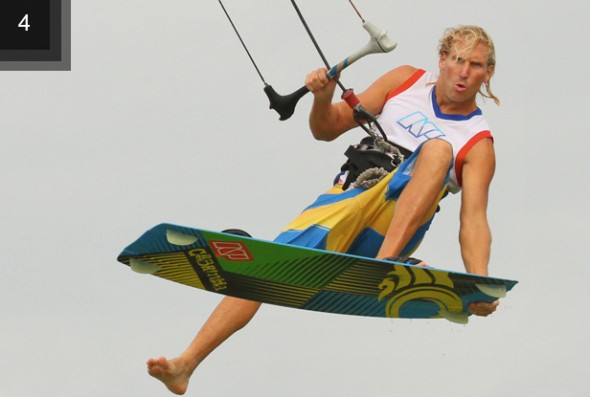 as this will aid twist the board off your foot. At the same time lift your front foot towards you, your foot will now be dangling in told air. Keep your hold tight on the board and keep your bar in for float. From this moment you have a plethora of alternatives to show-off, the most significant of which is to get your front leg extended as the guy has in the images. As you get confident you can play with board angles and leg positions. As per any reasonably high and float jump, aim to keep the kite just behind at the angle of 12 o’clock so that you don’t get pulled forwards and off balance whilst in flight.
as this will aid twist the board off your foot. At the same time lift your front foot towards you, your foot will now be dangling in told air. Keep your hold tight on the board and keep your bar in for float. From this moment you have a plethora of alternatives to show-off, the most significant of which is to get your front leg extended as the guy has in the images. As you get confident you can play with board angles and leg positions. As per any reasonably high and float jump, aim to keep the kite just behind at the angle of 12 o’clock so that you don’t get pulled forwards and off balance whilst in flight.
Image-5(Eyes and In)
 In the time when you are learning this, once you experience that you’re dropping it’s your signal for font foot in. This way you’ll have sufficient time. Once you get more proficient and confident you can wait until mill moments before landing. To make life easier and give you a bit longer you should start to pull gently on your front hand. This way the kite will fly at 12 o’clock and you’ll be satisfied with a little extra lift, and therefore time. If you don’t perform this, you’ll drop much quicker. Fix your gaze on the front strap and pull your back knee up, which will tilt the nose of the board down. Bend your front leg to bring your foot up and if your strap is loose it should be a fairly simple procedure. Once your foot is in give it a wiggle whilst you still have hold of the tail to make sure that it’s secure.
In the time when you are learning this, once you experience that you’re dropping it’s your signal for font foot in. This way you’ll have sufficient time. Once you get more proficient and confident you can wait until mill moments before landing. To make life easier and give you a bit longer you should start to pull gently on your front hand. This way the kite will fly at 12 o’clock and you’ll be satisfied with a little extra lift, and therefore time. If you don’t perform this, you’ll drop much quicker. Fix your gaze on the front strap and pull your back knee up, which will tilt the nose of the board down. Bend your front leg to bring your foot up and if your strap is loose it should be a fairly simple procedure. Once your foot is in give it a wiggle whilst you still have hold of the tail to make sure that it’s secure.
Image-6(Both Hands and Dive)
 Now all that’s left is to land this with panache and you’ll feel quite chuffed. Once your foot is in release the grab and get you back hand on the bar. You’ll need to dive the kite hard for landing because you gave it a little pull forward for support whilst replacing the front foot, so if you’re not aggressive now you’ll get pulled off balance as the kite flies around the edge of the window. You can see that rider is giving the bar a fair yank down to dive the kite and as it pulls he angles the board off the wind for a soft downwind landing.
Now all that’s left is to land this with panache and you’ll feel quite chuffed. Once your foot is in release the grab and get you back hand on the bar. You’ll need to dive the kite hard for landing because you gave it a little pull forward for support whilst replacing the front foot, so if you’re not aggressive now you’ll get pulled off balance as the kite flies around the edge of the window. You can see that rider is giving the bar a fair yank down to dive the kite and as it pulls he angles the board off the wind for a soft downwind landing.
Top Tips
1. Approach your first few attempts with an aggressive jump, a boned grab and a subtle look back to get your confidence up.
2. Then loosen the straps and give it a go.
3. You’ll be surprised how both the grab and the back foot act as anchor points, making this feel far more solid and controlled than you would expect.
Common Problems
- First off, struggling to get the foot out. Assuming that you have loosened the strap or straps the primary cause of this will be your legs. If you bring your front knee right up into your chest you’ll have no room to lift your foot out. Similarly if you don’t lift your back knee enough you may have the some problem.
- Make sure you get a decent tilted angle on the board, as this will make a world of difference.
- If you’re getting stuck looking back and then dropping down into the drink. Chances are that you’re being a bit ginger on the front hand and leaving the kite too far behind you after take-off. Remember to fly the kite back up to just behind 12 o’clock with two hands as you bring your knees up. Don’t go for the grab until you have the kite settled.
- When you’re having problems getting the foot back in it’s either going to be lack of time and height, so make sure that you pull gently on the front hand as you slide it back in. It could also be the knees again, so make sure the board is tilted.
Keystones
- Elevator jump
- Control kite with two hands
- Tilt board back knee up into chest and grab
- Pull board in and lift foot out
- Tilt, look at strap and slide foot in
This video shows how you can progress your jumps and not only to take your one foot of from the board but both feet and even flip the board! Practise and you’ll become the jumping king at your local kite spot in no time!
